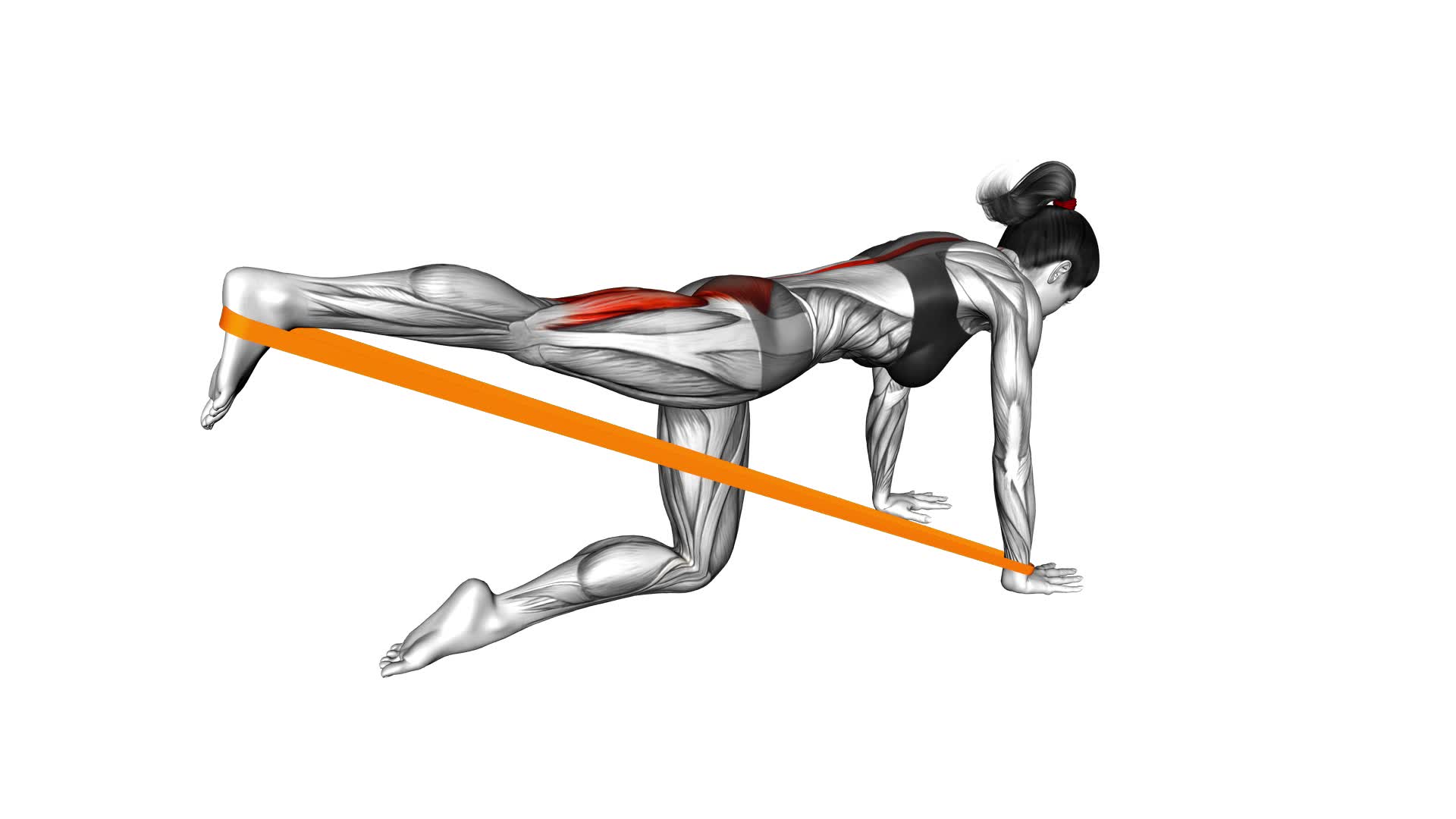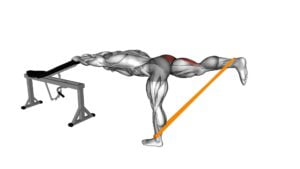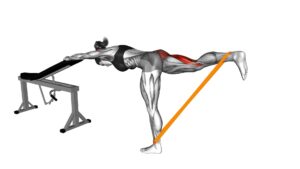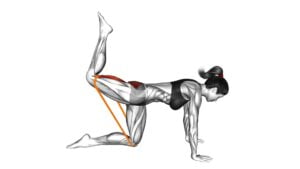Resistance Band Leg Kickback – Video Exercise Guide & Tips

Looking to strengthen your legs and glutes? Check out this video exercise guide on resistance band leg kickbacks. In just a few minutes, you'll learn the proper form and variations of this effective exercise.
Watch This Exercise Video
Get ready to feel the burn and see results with this simple yet challenging workout. Don't miss out on these tips for getting the most out of your resistance band leg kickbacks.
Let's get started!
Key Takeaways
- Resistance band leg kickbacks target multiple muscle groups including the glutes, hamstrings, and quadriceps.
- These exercises help to strengthen and tone the leg muscles.
- Using a resistance band adds an extra challenge and increases the intensity of the workout.
- Proper form and muscle activation cues should be followed to maximize results and avoid common mistakes.
Benefits of Resistance Band Leg Kickbacks
By incorporating resistance band leg kickbacks into your workout routine, you can experience a range of benefits. One of the main advantages of this exercise is that it targets your glutes, hamstrings, and quadriceps, helping to strengthen and tone these muscles. The resistance from the band adds an extra challenge, making your muscles work harder. Additionally, resistance band leg kickbacks can improve your balance and stability as you engage your core to maintain proper form throughout the movement.
Another benefit of this exercise is its versatility. There are various variations you can try to target different muscle groups or add more intensity to your workout. For example, you can perform side leg kickbacks to work your outer thighs or standing kickbacks to engage your calf muscles. You can also adjust the resistance of the band to suit your fitness level and gradually increase it as you get stronger.
Now that you know about the benefits of resistance band leg kickbacks, let's move on to the equipment needed for this exercise.
Equipment Needed for the Exercise
To continue with the discussion on equipment needed for the exercise, let's move on to what you'll require to perform resistance band leg kickbacks.
Resistance bands are a versatile and effective tool for strengthening and toning your leg muscles. They offer several benefits compared to traditional weights, such as providing constant tension throughout the entire range of motion, targeting multiple muscle groups simultaneously, and being easily portable for use anywhere.
When it comes to resistance band leg kickbacks, you'll need a resistance band with handles. This type of band allows for a secure grip and better control during the exercise. Make sure to choose a band with suitable resistance level based on your fitness level and goals.
In addition to the resistance band, you may also want to consider using ankle straps. These straps attach to the resistance band and wrap around your ankles, providing stability and preventing the band from slipping. Ankle straps can enhance the effectiveness of the exercise and make it more comfortable.
It's important to note that resistance bands can be used for various exercises, not just leg kickbacks. They can be utilized for exercises targeting the arms, shoulders, back, and core muscles. So, investing in a set of resistance bands will give you a wide range of workout options to keep your fitness routine diverse and challenging.
Proper Form for Resistance Band Leg Kickbacks
To perform resistance band leg kickbacks with proper form, there are a few important points to keep in mind.
First, focus on activating your glutes by squeezing them at the top of the movement.
Second, avoid swinging your leg or using momentum to lift the resistance band.
Finally, choose a resistance band that provides enough challenge without compromising your form.
Muscle Activation Cues
Ensure proper muscle activation during resistance band leg kickbacks by using a firm yet controlled motion. To maximize your results and effectively target the muscles, follow these muscle activation cues:
- Engage your glutes: Squeeze your glutes at the top of the kickback movement to activate and fully engage the muscles. This will help you achieve a stronger contraction and better results.
- Maintain proper alignment: Keep your core engaged and your back straight throughout the exercise. This will ensure that the muscles are working in the correct position and prevent any unnecessary strain on your lower back.
- Control the movement: Avoid swinging or using momentum to lift your leg. Instead, focus on a slow and controlled motion, emphasizing the contraction of your glutes. This will help you maintain tension on the muscles and optimize your muscle activation.
Common Mistakes to Avoid
Now let's discuss the common mistakes to avoid when performing resistance band leg kickbacks to ensure proper form.
One common mistake is swinging the hips during the exercise. It's important to keep your hips stable and stationary throughout the movement. This will ensure that you're targeting the correct muscles and getting the most out of the exercise.
Another mistake to avoid is neglecting to maintain core stability. Your core muscles, including your abs and lower back, play a crucial role in providing support and stability during resistance band leg kickbacks. Engaging your core will help you maintain proper form and prevent any unnecessary strain on your lower back.
Remember to focus on keeping your hips steady and your core engaged to maximize the effectiveness of the exercise.
Recommended Resistance Band
To achieve proper form and maximize the effectiveness of resistance band leg kickbacks, it's recommended that you use an appropriate resistance band. Using the right resistance band can provide several benefits in your workout routine. Here are three different types of resistance bands that you can consider:
- Mini Bands: These small loop bands are perfect for beginners or individuals looking to add resistance to their leg kickbacks. They're lightweight and versatile, allowing you to perform a wide range of exercises.
- Tube Bands with Handles: These bands come with handles on each end, providing a comfortable grip and allowing you to perform leg kickbacks with ease. They also come in different resistance levels, allowing you to progress as you get stronger.
- Fabric Bands: These bands are made of fabric and have a non-slip design, making them perfect for leg kickbacks. They offer varying resistance levels and are durable, making them suitable for intense workouts.
Using the right resistance band can help you target your glutes effectively and enhance your leg kickback workout. Now, let's move on to the next section and explore the different variations of resistance band leg kickbacks.
Variations of Resistance Band Leg Kickbacks
To add variety and challenge to your resistance band leg kickbacks, try incorporating different variations into your workout routine.
If you're looking for resistance band alternatives, one option is to use ankle weights instead. Ankle weights can provide a similar resistance to the bands and can be easily adjusted to increase or decrease the intensity of the exercise.
Another variation for advanced users is the single-leg resistance band kickback. Instead of using both legs at the same time, perform the exercise with one leg at a time. This will require more stability and strength from your supporting leg, increasing the difficulty of the exercise.
Additionally, you can try using a thicker resistance band or doubling up on bands to further challenge your muscles.
By incorporating these variations into your resistance band leg kickbacks, you can target different muscle groups and prevent plateauing.
Now, let's move on to some tips for getting the most out of your workout.
Tips for Getting the Most Out of Your Workout
To maximize your workout results, incorporate these tips for getting the most out of your resistance band leg kickback exercise:
- Use the right resistance band: Choose a band that provides enough tension to challenge your muscles without causing strain or discomfort. Using the appropriate resistance will help you maximize results and prevent injury.
- Focus on proper form: Maintain a stable stance with your feet hip-width apart and your core engaged. Keep your back straight and avoid arching or rounding your spine during the movement. This will ensure that you're targeting the correct muscles and minimizing the risk of injury.
- Control the movement: Slow and controlled movements are key to maximizing the effectiveness of your leg kickbacks. Avoid using momentum or swinging your leg, as this can reduce the engagement of your glutes and hamstrings. Instead, focus on squeezing your glutes at the top of the movement and maintaining tension throughout.
By following these tips, you can maximize your results and prevent injury during your resistance band leg kickback exercise.
Now, let's explore the common mistakes to avoid during this exercise.
Common Mistakes to Avoid During Resistance Band Leg Kickbacks
To ensure you're performing resistance band leg kickbacks correctly, it's important to pay attention to proper form. Watch the demonstration video to see how to position your body and maintain proper alignment throughout the exercise.
Additionally, be mindful of avoiding excessive momentum, as this can compromise the effectiveness of the movement and increase the risk of injury.
Proper Form Demonstration
During your resistance band leg kickbacks, it's important to be mindful of the common mistakes to avoid. Proper form is essential to ensure effective muscle targeting and to prevent injuries. Here are some key points to remember:
- Keep your core engaged: Maintain a stable and neutral spine throughout the movement by contracting your abdominal muscles. This will help to protect your lower back and improve balance.
- Maintain a controlled motion: Avoid swinging your leg or using momentum to lift the resistance band. Instead, focus on a slow and controlled movement, squeezing your glutes at the top of the kickback.
- Choose the right resistance: Ensure that the resistance band you're using challenges your muscles without compromising your form. If the band is too light, your glutes may not be effectively targeted. If it's too heavy, you may strain your muscles or compromise your technique.
Avoiding Excessive Momentum
Maintaining control and avoiding excessive momentum is crucial for effective resistance band leg kickbacks.
To avoid jerky movements, focus on controlling the entire range of motion.
Start by attaching the resistance band securely to a sturdy anchor point and then loop it around your ankle.
Stand tall with a slight bend in your supporting leg and engage your core for stability.
Slowly extend your leg straight back, keeping your foot flexed and your glutes engaged.
Avoid swinging your leg or using momentum to lift it higher.
Instead, focus on the contraction of your glutes as you squeeze your leg back.
Frequently Asked Questions
How Many Sets and Repetitions Should I Do for Resistance Band Leg Kickbacks?
To get the most out of resistance band leg kickbacks, it's important to know how many sets and repetitions to do. For this exercise, aim for 3 sets of 12-15 repetitions.
This will help target and strengthen your glutes and hamstrings. Remember to maintain proper form throughout the exercise.
If you're looking for alternative exercises, you can try glute bridges or donkey kicks, which also work the same muscle groups.
Can Resistance Band Leg Kickbacks Help Me Build Muscle in My Glutes?
Resistance band leg kickbacks can definitely help you build muscle in your glutes. Compared to traditional glute exercises, using resistance bands adds extra resistance throughout the entire range of motion, making your muscles work harder. This can lead to increased muscle activation and growth in your glutes.
Incorporating resistance bands into your leg workouts also helps improve stability and balance, targeting different muscle fibers for a more well-rounded workout.
Are Resistance Band Leg Kickbacks Suitable for Beginners?
Resistance band leg kickbacks can be a suitable exercise for beginners. They provide a low-impact way to target your glutes and build strength.
If you're just starting out, you can modify the exercise by using a lighter resistance band or performing the movement without the band altogether.
Additionally, there are alternative exercises like glute bridges or clamshells that can also help activate and strengthen your glutes.
Remember to start slowly and listen to your body to avoid any injuries.
Can I Use a Resistance Band With Handles for This Exercise?
Yes, you can use a resistance band with handles for this exercise. Resistance bands with handles provide a comfortable grip and make it easier to perform leg kickbacks.
However, if you don't have a resistance band with handles, there are alternative exercises you can try.
Resistance bands offer a variety of benefits, such as improving muscle strength and flexibility. They're also portable and versatile, making them a great addition to any workout routine.
Can Resistance Band Leg Kickbacks Help With Knee Pain?
Resistance band leg kickbacks can be beneficial for knee pain. By strengthening the muscles around the knee joint, these exercises can help provide stability and support, potentially reducing discomfort.
Additionally, resistance band leg kickbacks offer variations for different fitness levels, allowing you to adjust the intensity and challenge as needed.
Whether you're a beginner or more advanced, incorporating resistance band leg kickbacks into your workout routine can be a helpful way to address knee pain and improve overall lower body strength.
Conclusion
In conclusion, resistance band leg kickbacks are a highly effective exercise for targeting and strengthening the glutes and hamstrings. By using a resistance band, you can add intensity and challenge to your workout routine.
Remember to maintain proper form and utilize variations to target different muscles. By following these tips and avoiding common mistakes, you can maximize the benefits of resistance band leg kickbacks and achieve your fitness goals.

Author
Years ago, the spark of my life’s passion ignited in my mind the moment I stepped into the local gym for the first time. The inaugural bead of perspiration, the initial endeavor, the very first surge of endorphins, and a sense of pride that washed over me post-workout marked the beginning of my deep-seated interest in strength sports, fitness, and sports nutrition. This very curiosity blossomed rapidly into a profound fascination, propelling me to earn a Master’s degree in Physical Education from the Academy of Physical Education in Krakow, followed by a Sports Manager diploma from the Jagiellonian University. My journey of growth led me to gain more specialized qualifications, such as being a certified personal trainer with a focus on sports dietetics, a lifeguard, and an instructor for wellness and corrective gymnastics. Theoretical knowledge paired seamlessly with practical experience, reinforcing my belief that the transformation of individuals under my guidance was also a reflection of my personal growth. This belief holds true even today. Each day, I strive to push the boundaries and explore new realms. These realms gently elevate me to greater heights. The unique combination of passion for my field and the continuous quest for growth fuels my drive to break new ground.







